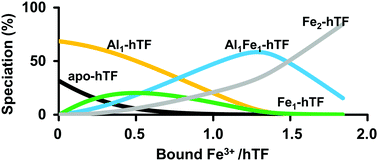Competition between Al3+ and Fe3+ binding to human transferrin and toxicological implications: structural investigations using ultra-high resolution ESI MS and CD spectroscopy
Abstract
Human serum transferrin (hTF) is an iron binding protein with the primary task of ensuring well-controlled transport of Fe3+-ions in the bloodstream. Furthermore, hTF has been identified as a key component in the trafficking of Al3+-ions from the serum to cells. It is clear that binding alone does not guarantee cellular uptake via the transferrin receptor, since this is determined by the structural properties of the metal–protein complex. The conformation of the metallated hTF is critically important for delivery of Fe3+ or any other metal into the cell. The combination of ultra-high resolution ESI mass spectrometry and CD spectroscopy together provide accurate species distribution of the Fe3+ during stepwise addition to apo-hTF and an indirect indication of the tertiary structure of the metallated protein. These two methods together are extremely fine probes of structural changes as a function of precise metal binding status at micromolar concentrations. Simulation of the precise domain distribution could be determined during the stepwise metallation from 0 to 2 Fe3+ added. Analysis of the ESI-MS data for the stepwise metallation of apo-hTF and Al1 or 2-hTF with Fe3+ was carried out and used to simulate the experimental speciation based on the reported KF values. There are six main conclusions: (1) Fe3+ binds predominantly, initially to the C-lobe. (2) The CD spectral properties indicate that the C-lobe metallation dominates the structural properties of both binding sites; N-lobe metallation modifies the C-lobe structure. (3) Fe3+ metallation of the mixed Al1–2-hTF results in the dominant form of Fe1Al1-hTF. (4) The first Fe3+ bound to Al1-hTF binds predominantly in the C-lobe domain. (5) The CD spectral properties when Fe3+ binds to Al1–2-hTF indicates that Al–N-lobe occupation mirrors the structural effects of N-lobe occupation by Fe3+. (6) With respect to how Al3+ might enter the cell, the formation of a hybrid form Al1Fe1-hTF might enable the Al3+ to enter the cell via receptor-mediated endocytosis due to the binding of Fe3+ in the C-lobe of the protein which is primarily responsible for the structure of the metal–protein complex.



 Please wait while we load your content...
Please wait while we load your content...